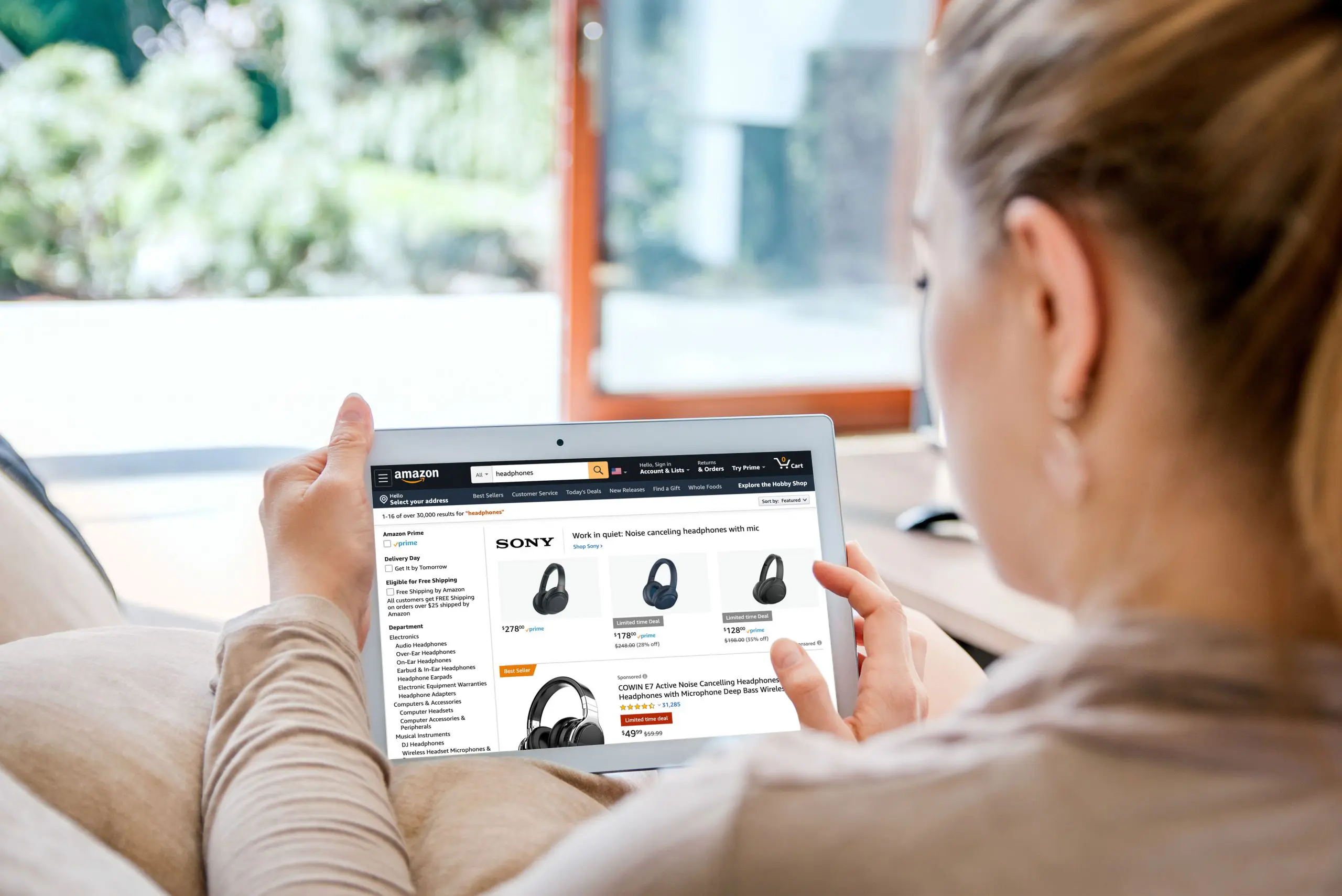
The Ins and Outs of Amazon Advertising: What Makes It a Whole New Beast
When someone says you can find anything on Amazon, they’re not far off from the truth. The online retailer and juggernaut rolled out Amazon Advertising in 2008 and, since then, it’s given product-based brands another avenue to reach consumers. But how does this complicated site work in favor of your brand? And what are the benefits? We look into that and more.
What does it mean to advertise on Amazon?
Amazon created its advertising business to “marry e-commerce and advertising” and help brands optimize the digital assets that Amazon owns. Because Amazon is a data-based business, it already has a pretty good idea about consumer shopping habits. (Which you know if you’ve ever seen an Amazon banner ad for something you swear you were just thinking about). This aids in its advertising approach and algorithm.
As a rule, brands that offer a tangible product to consumers benefit from Amazon advertising.
Small-to-midsize businesses (SMBs), for example, advertise on Amazon to improve their brand visibility and boost their sales. SMBs typically become part of Amazon Storefronts, a sector of Amazon Advertising which showcases products from these US-based businesses divided by category or collections. The official Amazon Advertising landing page boasts four main categories: sponsored products, sponsored brands, sponsored display (beta), and stores. Other advertising products they provide include things like video and audio ads and Amazon DPS.
All that to say that Amazon Advertising is a relatively new channel that’s disrupting the marketing industry. Especially for e-commerce brands.
Know your options
Before jumping into any platform, you should explore your marketing options.
Sponsored Products
Amazon Sponsored Products is the most popular advertising method because of its ability to target shoppers. Simply put, these ads “drive Amazon searchers directly to a specific product you’re selling on Amazon.” Product ads are keyword-targeted so you can set an exact match, phrase, or broad match and a daily budget to reach the most consumers.
Sponsored Brand Programs
This Amazon marketing option is specifically available for sellers who are part of the Brand Registry Program. Sponsored Brand Programs allow you to “have a banner ad at the top and the bottom of the search results page and on side columns.” Similar to Sponsored Products, you can use keywords to target your audience. But unique to this offering is creating a tagline and displaying three products in the ad.
Product Display Ads
Product Display Ads function differently than the above two options. Instead of being keyword targeted, these ads are interest or product targeted. That means “they drive shoppers to the products detail page and are also priced by a cost-per-click method.” Most often, the Product Display Ads appear at the right or bottom of search results along with similar products.
Amazon Demand-Site Platform (DSP Platform)
The DSP Platform on Amazon is primarily for bigger brands that are looking to increase brand awareness. These ads usually show up on apps with ad formats including mobile banners, videos, desktop, and mobile web display. The goal with these “is building brand awareness rather than increasing sales through a single ad.”
Amazon marketing benefits
If you haven’t noticed, Amazon is massive and only growing as a platform. And, with this growth, comes significant benefits for your e-commerce brand.
Amazon SEO
SEO is to brands what frosting is to a cake pop––it keeps the whole thing together. This is especially true when it comes to data-driven platforms like Google and Amazon. Their algorithms are always on the watch, looking for keywords that they can put in front of consumers.
And “because Amazon holds leading positions in Google’s search results, having accurate data to properly portray your brand is even more important. Amazon has strong positioning in Search Engine Optimization, and your brand’s presence on Amazon can share this value if managed properly.” What does this mean? Amazon’s SEO helps to get your products noticed by consumers who will (hopefully) buy them.
Think of it this way: when shopping online for yourself, where do you start your search? Likely Amazon. And, once there, how likely are you to purchase one of the results from the first page, maybe the second if you’re feeling especially adventurous? Amazon SEO is essentially product optimization. It helps to improve your visibility so you can get to the top of search results. Great starting places for this are in your product title, features, description, and images.
PPC Promotion
We talked a little about the main Amazon marketing categories before, but there’s a strategy to how they work. Pay-per-click (PPC) promotion can be vital for your brand’s exposure. Depending on the category chosen and the amount spent, your Amazon ad will yield different results.
Sponsored Product Ads, for example, are built not only for the clicks but for the follow-through (hello “add to cart”). With Sponsored Brands, your products will appear first and on product detail pages, which “allow you to reach and snatch shoppers from your competitor.”
If you’ve ever scrolled to the reviews of a product only to be led astray by a different brand with a similar item, you’ve seen Amazon’s PPC in action. Bonus: this PPC option with Sponsored Brands also comes in handy if you’re low on inventory for one product and want to recommend a similar one from your brand. Making sure another brand doesn’t take that space.
Global reach
Depending on your brand goals and scalability, global reach could be a huge deal for you. As of 2020, Amazon operates 14 worldwide marketplaces. What’s more, “the products campaigned via PPC or sponsored posts get global visibility and impression.” This exposure can equal millions of views within a short time. That’s a lot of extra brand exposure that you might not achieve on another platform.
Targeting buyers, not viewers
Last but not least, shoppers on Amazon are generally there to, well, shop. They’re less likely to be casual purveyors of products and likely already have a good idea of what they need. But that doesn’t mean a relevant and well-timed ad can’t sway them.
Things like Amazon Display Ads offer brands the chance to target these buyers on category pages while searching for something else. They could also show up on “ESPN.com, CNN, or any site that’s part of the Google display network since the Google AdX exchange is part of the Amazon DSP offering.” Exposure, repetition, and strategy are the keys to reaching your buyers here.
How to get started
If you’ve made it this far, you must be interested in advertising on Amazon. Getting started with a new marketing channel can sometimes throw a wrench in a previously buttoned-up marketing strategy, but it doesn’t have to. The ways to get started with Amazon advertising are not unlike other platforms you’re probably already using.
Focus on keywords
There’s that word again: keywords. But if you’re an established brand, you should already have a keyword strategy in place and a good idea of which ones are getting you results. If you need inspiration, you can always check out which keywords your competitors are using. But a good rule of thumb here is to use both positive and negative keywords to target the exact audience you need.
Create intriguing copy
For ads that require slightly more copy like the Sponsored Brand Programs, it pays to get creative with your copy. Create an engaging call to action, describe your product in interesting detail, and create a sense of urgency.
Watch your competitors
It helps to see what your competitors are doing in the ad space before launching your ad. Find competitors by doing a “generic search on Amazon for products in your vertical and see which brands come up the most in your search results.” Go a step beyond this and bid on keywords that these brands are using to find a foothold in search results.
Take risk and experiment
Maybe most importantly, take some risk, and don’t be afraid to try all three main ad formats. This way, you can see which yield the highest returns and which your key audience responds to the best. You may even discover something new about your marketing strategy in the process.
Amazon advertising as a Savy service
Amazon advertising is complicated. So having a dedicated marketing team like Savy in your corner is helpful. Our agency gets to know your brand and can expand that expertise to Amazon as a new channel. Another benefit? We know from experience and research that consumers typically bounce across platforms, so making your e-commerce brand omnichannel can have positive results for your bottom line.
As with any marketing platform, Amazon’s advertising services are always in flux. We work with your team to create a seamless user experience across all of your brand’s channels. When it comes to Amazon advertising, we stay up-to-date with their changing policies and procedures. Our main goal is getting your product in front of the right consumers at the right time.
New channel, same goals
We know all too well how overwhelming it can be to find the right channels to reach your audience. And just when you think you’ve got it down, emerging players like Amazon Advertising disrupt the space and make your strategy. Savy has worked with big and small brands, e-commerce and service-centric, to help find their niche audiences and best marketing channels. The principle is the same with Amazon Advertising: get in front of buyers, build brand loyalty, and increase sales. What’s your brand waiting for?
Recent Posts
Custom Website Design and Development vs. Off-the-Shelf: What’s Right for Your Business?
Having a website that represents your brand and serves your business effectively can make or break your success in 2025. This poses the important question: Should you opt for custom […]
Read MoreHow to Rebrand Your Instagram for Better Engagement and Brand Recognition
Your Instagram presence can act as a beacon for brand recognition and customer engagement. It’s about painting a picture so compelling that your audience cannot help but be drawn to […]
Read MoreFrom Clicks to Conversions: The Science of High-Performing Digital Ads
The journey from interest to purchase is often paved with digital advertisements. However, not all digital ads are crafted equally. While some fade into the background, others command attention and […]
Read MoreBrand Consistency Examples That Will Make You Rethink Your Marketing Strategy
A consistent and strategic brand identity across all platforms is not just beneficial; it’s essential. By exploring real-world brand consistency examples, we uncover the immense power of maintaining a coherent […]
Read More3 Ways to Transform Blogs With SEO and Make Google Love Your Content
As marketers and business owners, our goal is to ensure the blogs we publish confidently stride into the spotlight of Google’s top search results. Achieving this requires great content, but […]
Read More



